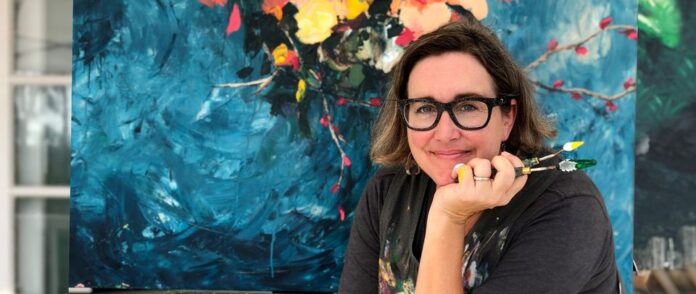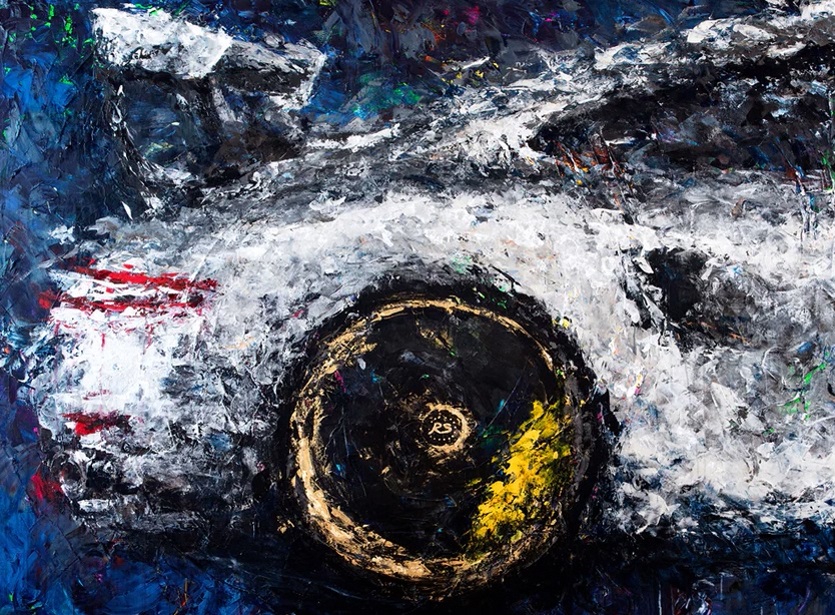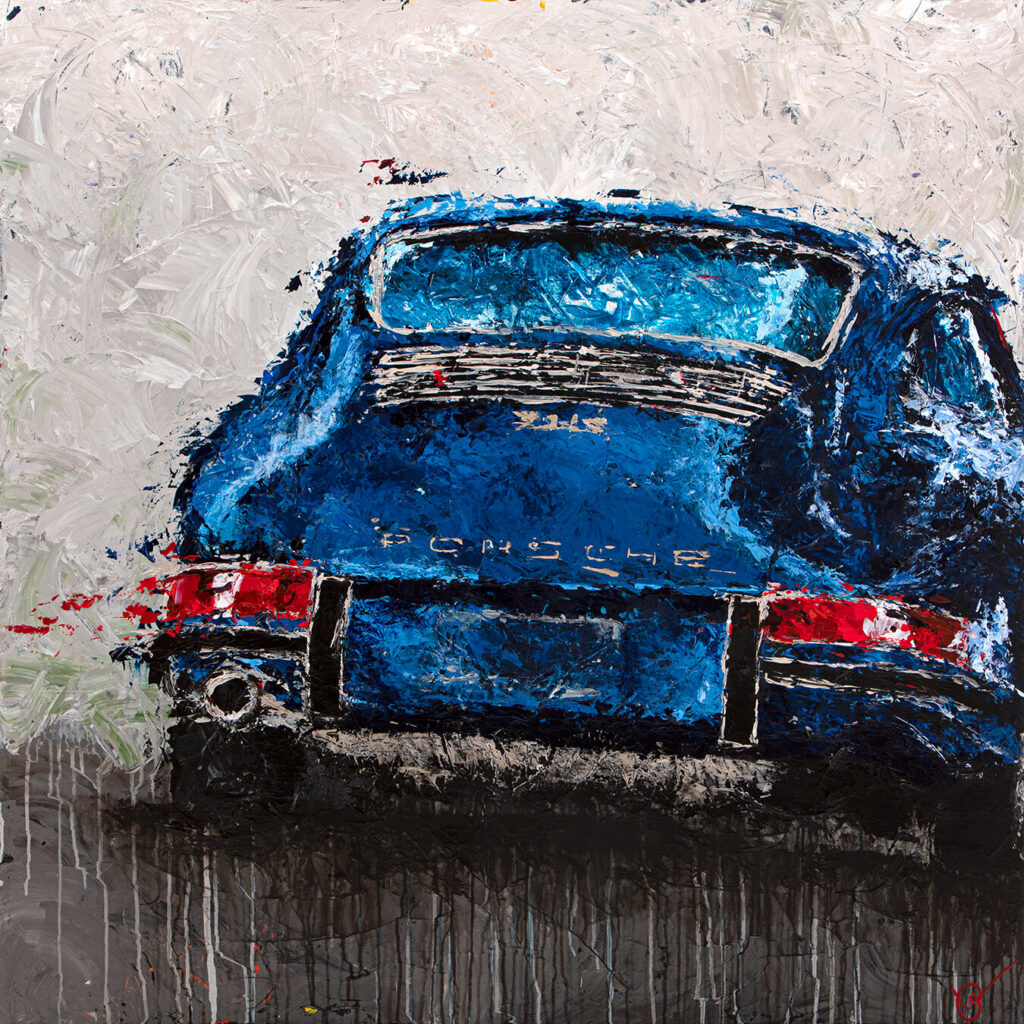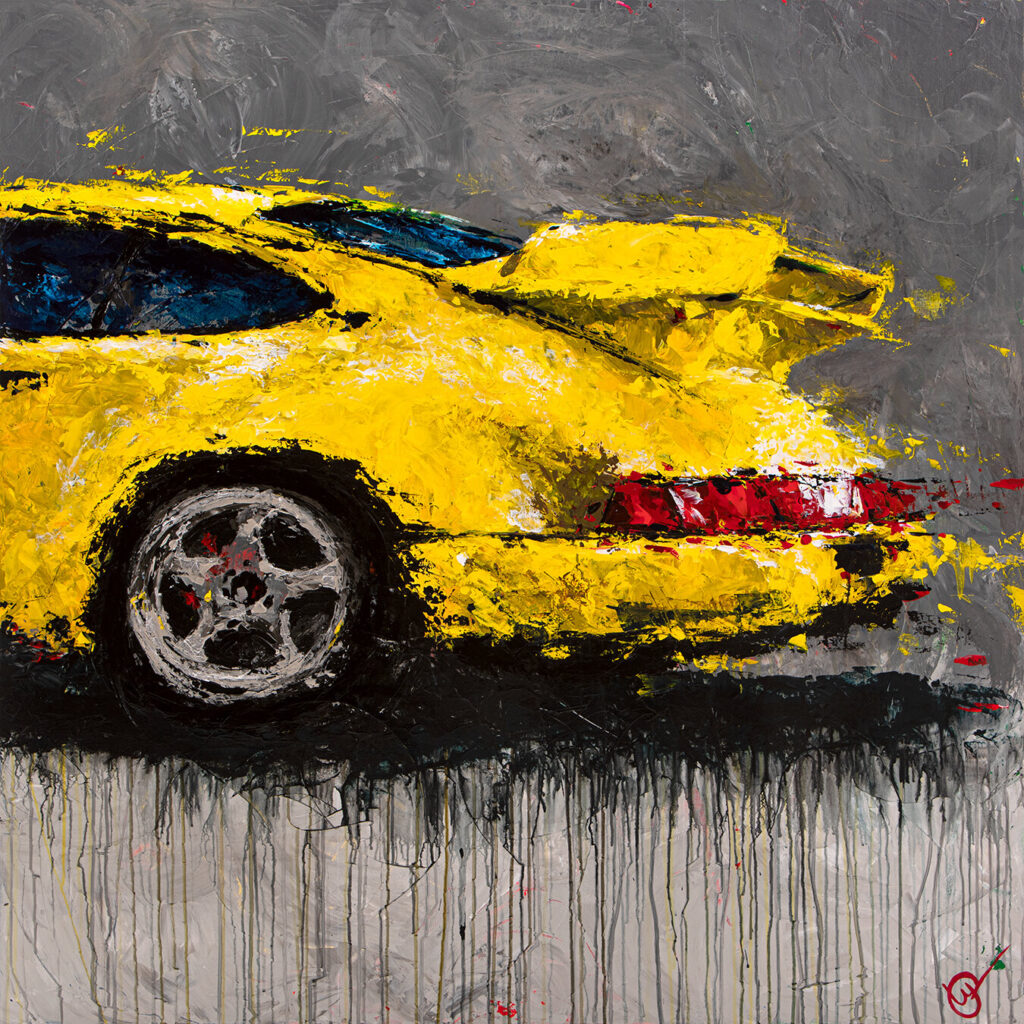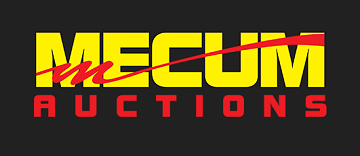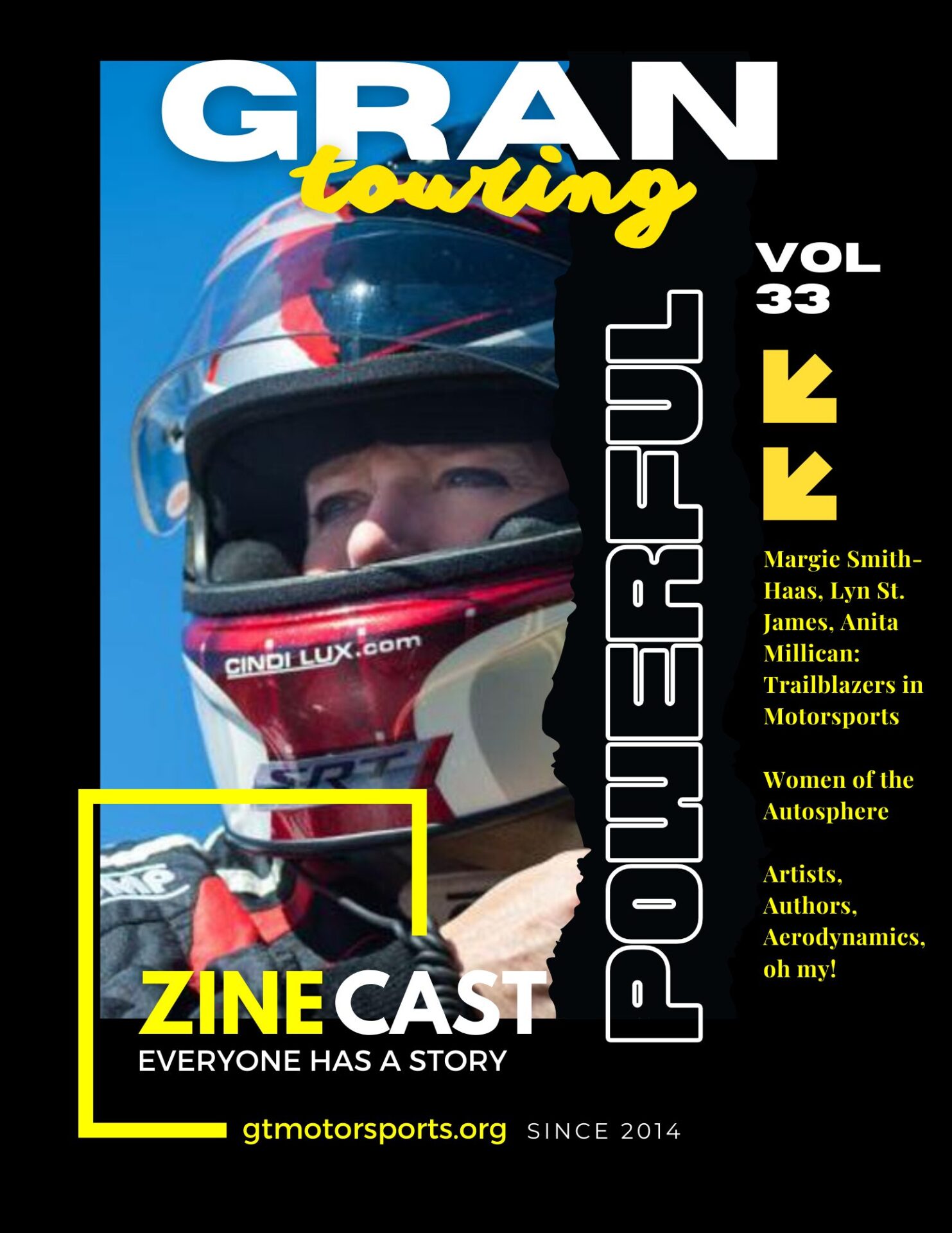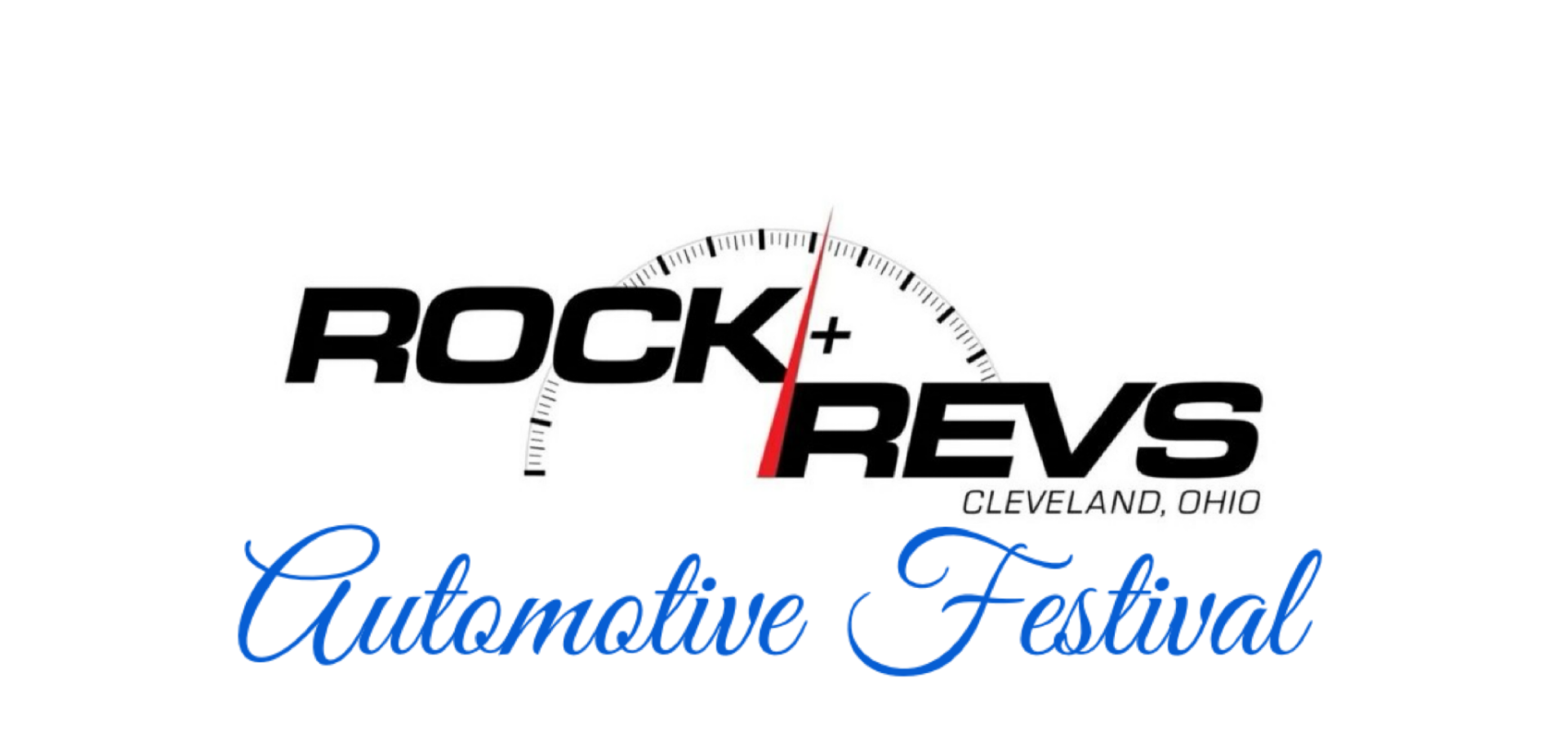Studying art at the Pratt Institute in New York, our guest ended up working in the business world as the trade show manager for PRI – the Performance Racing Industry. For nearly a decade, she enjoyed everything about the racing industry and learned the value of good business acumen.
Those early experiences helped shape the course of Lyn Hiner’s life as she decided to become a professional artist. And she’s here with us on Break/Fix to share her story with YOU!
Tune in everywhere you stream, download or listen!
 |  |  |
- Spotlight
- Notes
- Transcript
- Highlights
- Learn More
Spotlight
Lyn Hiner - Artist for Lyn Hiner Studios
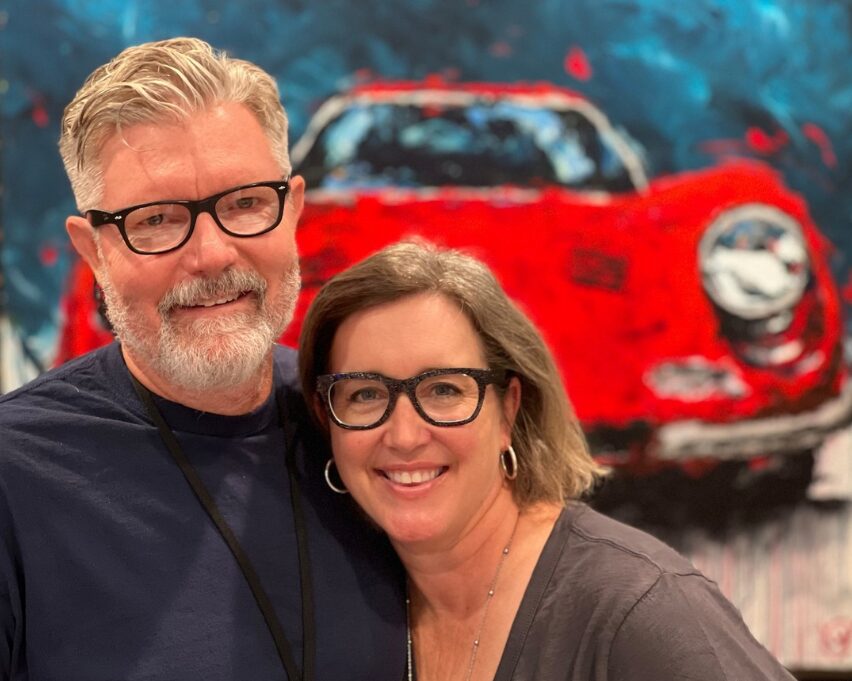
My passion is recreating what I see; primarily in nature, but also the beauty in man-made structures and in the abstract.

Contact: Lyn Hiner at studio@lynhiner.com | N/A | Visit Online!![]()
![]()
![]()
![]()
![]()
Notes
- Which came first, the artist or the petrol-head?
- There’s so many facets to Art and Painting – How did you decide to pair the two together? What was the inspiration? Was it a race/event, a car, a photograph you saw?
- The Accident – “Petals” collection, initially titled “Beauty from Ashes”
- There’s all sorts of different styles of Art – what’s your chosen style/medium, and why?
- There’s a new trend of “photo realistic” paintings popping up all over social media; what are your thoughts on these types of pieces?
- There’s also a conversation to be had around AI-generated art, new systems like Stable Diffusion, Dall-E, Midjourney – in your opinion where is their place in the future of Art?
- How do you choose what you’re going to paint next?
- Acquiring Lyn Hiner art: Do you work on custom commissions? Where can someone purchase one of your pieces?
- What’s next for Lyn Hiner?
and much, much more!
Transcript
Crew Chief Brad: [00:00:00] BreakFix podcast is all about capturing the living history of people from all over the autosphere, from wrench turners and racers to artists, authors, designers, and everything in between. Our goal is to inspire a new generation of petrolheads that wonder. How did they get that job or become that person?
The road to success is paved by all of us because everyone has a story.
Crew Chief Eric: Studying art at the Pratt Institute in New York. Our guests ended up working in the business world as a trade show manager for PRI. You might be familiar with a performance racing industry. And for nearly a decade, she enjoyed everything about the racing industry and learn the value of good business acumen.
But those early experiences helped shape the course of Lynn Hiner’s life as she decided to become a professional artist. And she’s here with us on Break Fix to share her story with you. And with that, welcome to Break Fix, Lynn. Thank you for having me, Eric. Well, like all good [00:01:00] Break Fix stories, there’s a superheroine origin story.
So tell us about your time at PRI and how that transformed into becoming a professional artist.
Lyn Hiner: Well, I think the professional artist track was probably earlier. Established then PRI. PRI was my, Oh nuts. I need to actually make money. To be blunt and honest, one of the things my dad had said when I said I wanted to apply to art school was, Hey.
No problem. Just find a way to make money on it. And that’s what I wanted to do, but I didn’t actually finish school. So when I came out of school and I came back to California, I actually started a little road trip of my own of what’s going to be the fit and the fit happened with PRI trade show manager came as I went along and honestly, the journey has been littered with a lot of superheroes.
My dad, my mom, the guy I worked for Steve Lewis, he actually taught me so much. About business. And I would have [00:02:00] never guessed it would have affected this path that I’m on now. It did. And so I’d have to say the family who has supported and even pushed at times, but also been patient on the journey.
Crew Chief Eric: So while you were managing the trade show, which is a big to do, I mean, I’ve spent many a time in a convention center hall for other types of trade shows, including PRI there’s a lot to do.
There’s a lot of spinning plates. You mentioned that affected your art. And so were you always drawing and painting in the background? Were you doing it as a hobby? How did one influence the other?
Lyn Hiner: PRI wasn’t necessarily an influence on my art specifically. What it did was teach me how to run a business and anyone who actually wants to make money at art, you actually need to have some business acumen and some sense about you.
I don’t know why in art school, they don’t teach you that part. It’s such an important thing to know. Marketing, business, basic math, writing a letter. You know, those things are actually super important. My [00:03:00] boss, he would often say, Lynn, do you not know how to form a proper letter? Which is a little humbling to say that now, but it was true.
That was one of the things I didn’t really understand was just the language of business. And now I do.
Crew Chief Eric: So does the term starving artists? Apply to you or did you find your way to not
Lyn Hiner: know? I eat, I eat, I enjoy, I like a good bottle of red.
Crew Chief Eric: So with all of this that you learned through the business side of the autosphere, you were able to put food on the table, which is excellent.
And a lot of artists struggle with that. So what would you say is like the biggest thing? Outside of how to run a business that an artist needs to learn to really put themselves out there, maybe to market themselves, because that’s the other side, maybe the darker side of the business, especially today, when we think about it, social media and things like that,
Lyn Hiner: the professional side of doing art didn’t come to me until much later, even after I left PRI, I was mom for many years, and that was [00:04:00] my role and an important one.
And I was grateful for it. When the call came for being an artist, I didn’t go into it. Like, Ooh, I just want to do art. I hadn’t been creating in a very long time, but I knew the technical skills of it. And when I came back to it, I did a lot of research. I didn’t just wait for all that information to come to me.
I went and sought it out. Even as far as reading any newsletter, there’s an excellent, I would say shoes. Partly a mentor in a way for me, it was Maria Brophy. She reps a lot of artists. Well, specifically she reps her husband, but she trains or whatever. She comes alongside a lot of artists. She, she was writing only newsletters at the time when I came into it.
But she later wrote a book called art, money, success, and basically all the newsletters and all the podcasts and things I could hear from her, I devoured. And then any local artists, which at the time weren’t very many who would spend time [00:05:00] talking to me. I would reach out to them and ask them questions and of course, understanding business.
I didn’t do it while they were working. I would send them an email or ask, you know, Hey, can I pay you for your time? And out of the probably 20 that I reached out to, there was one local guy who is in his own right, very successful and has the most generous heart, Rick Delante. And he came over and spent hours with me.
I asked him, could you critique the work? Could you kind of take me through the process of how did you pick how much to charge and what did you do? And what do you, his generosity was that phrase, all boats rise with the tide. Reminded me that we can only be generous as far as we are willing to be generous.
And so from that, I’ve never, ever like any artist who’s ever asked me, I always will say, call me when I’m not working. Cause they’ll often ask me when they meet me while I’m working, but call me when I’m not working and let’s talk, let’s chat. And so that’s how I’ve spent more time with [00:06:00] Sam and with a handful of other artists.
I think that is the right thing to do.
Crew Chief Eric: Now we need to really peel back. Some of the layers here and talk about your petrol head side and we’re going to dive more into the artistry itself because there’s different types of art, you know, you’re not doing portraits and you’re not doing impressionism. You specifically are focusing in on automotive art and more importantly, Porsches.
Were you a petrol head before you were an artist? How did all this culminate?
Lyn Hiner: I grew up with my dad rebuilding and amateur racing Porsches. You can’t not have that influence your life. Gosh, I bet I could find it. I found it recently. There was a photo I pulled out from my high school wall and had a big Porsche with a whale tail on the back of it, and then I had a few posters on the other sides of it that I didn’t even remember I had, and there it was in this photo, and I was like, yeah, I geeked out, I geeked out on Porsches very specifically because my dad, he was the guy I.
Loved and admired. And here he was when I was very little, [00:07:00] had a Porsche, Hey, honey, put your hand on the shifter. Okay. Ready? Do you hear it? Do you hear it go? And he would have me shift. And so I would listen and I would understand and I would know. And then there were the smells and you know, your tiny little butts swishing around on the bucket seat of that car.
It cannot be undone. Those very formidable memories. Man, I loved them. I could tell you at night when they would drive by, I could hear them when I’m in my studio, my home studio, I can hear him go by and I know I immediately can see him drive by, I know the engine sound, everything. I don’t go in the engine and play around.
Let’s be fair. That’s not what I know. I know the car, I can point anything out. And as much as I love Porsches and I will always, you know, that will be my first love of cars. There are too many beautiful cars out there for me to not say. Uh, yeah, thank you. I will paint that. And yes, I would love to paint that.
I just finished two pieces for the upcoming Amelia Island Concours, DV5 and uh, Ferrari 330. They were stunning cars and I was grateful [00:08:00] to get to do them. Yeah, it’s not just Porsche in my paint world. So you asked me very specifically, how did I get there? Well, it was actually because I do other work. And in that other work, a collector asked me to do his car and it happened to be a Porsche.
And in doing that, I was like, okay, that was a lot of fun. Now, would I have put the two together when I came back to it professionally? Nope, not even a little, I never considered that to be a marriage made in heaven, I guess, because what I was doing was leaning into my fine art side. And at the point when I found my voice with knives.
Everything I knew about automotive artwork was very realistic. And so I don’t even think it was a fleeting thought until I did that car. I had fun. I had a great reaction on social media from people who saw me doing my other work. I was like, okay, is this a thing? Could I make this a thing? I don’t know if this is going to be a thing.
And all of a sudden I’m like, okay, this is the thing I’m going to do this other one and see if it’s a thing. So in the middle of prepping for another show, I put a blank [00:09:00] canvas on my easel and I pulled out a photo I had taken a year earlier at our local car show. And I started the same process I had done with that commission work that Portia, as I was putting the lines of this 427 Cobra on, I was like, I can see the whole collection.
I can see an entire body of work. I wonder if this is a thing. And as I was starting a third painting, a couple of months later, Peter McGillivray from SEMA reached out and said, Hey Lynn, If I found a spot for you, do you want to exhibit this? I like what you’re doing. Would you want to have a spot at Art Walk?
And I didn’t understand the gift he was giving me by that invite. If I had said no, I would have never had that opportunity and I would not be here now.
Crew Chief Eric: Well, you sort of walked us backwards into one of our most famous pit stop questions on Brake Fix, which is, you know, the most beautiful car of all time.
And so from an artist’s perspective, that’s quite subjective. You mentioned a few and I think it’s interesting that you did sort of cut your teeth on Porsches because especially the early Porsches are [00:10:00] unique in the car world because there’s not a seam on them. They’re very fluid in the design. They’re very round.
There aren’t any hard lines compared to other 50s and 60 cars of the time where you have big fins and angular lights and everything super futuristic looking. Maybe we put the Porsches aside or tell us what the best looking Porsche is, but what’s the most beautiful car of all time?
Lyn Hiner: Good gravy, Eric.
That’s a tough one. Cause there really are, if I’m going to go with my guttural first instinct, my first, like in my head, the car that I long to have would be a speedster without a doubt a speedster, but how do I not confess my absolute adoration for a five 50 spider, both Porsches. But if somebody is going to twist my arm, I am going to take my, I’m going to take it.
Let’s see, a 2 75 or three 30, I wouldn’t have a problem in the Ferrari realm. I would also add a Jaguar E type. No doubt in my mind, there are just too many beautiful cars and there’s my list, not [00:11:00] necessarily in a order of. Preference. But yeah, for sure. They would all be in my garage.
Crew Chief Eric: I’m glad you brought up the E type because it is our reigning champion.
A lot of people default that the E type Jag is one of the most beautiful designs. And I think second to that is the 250 Testarossa pontoon fender and a couple other cars of a similar era. It brings up a really interesting question. And this is specifically from a design language perspective as an artist, do you feel that modern car design Is on par with some of the classics.
Like, have we gone too far afield? There’s a lot of aerodynamicists that’ll say there’s one design that cheats the wind and that’s why Ferraris and NSXs and Corvettes all look the same. Now, do you think we’ve lost touch with design?
Lyn Hiner: I think we’ve lost touch with the beauty. I don’t know how else to say it.
Modern cars are aesthetically interesting. But I don’t know if I would categorize them as beautiful. And the problem for me is if it’s ever going to be part of my personal collection, the ones that I create at the beginning of the year, I almost [00:12:00] always, always lean into, I’d say probably 95 percent early sixties cars.
There are a few later sixties, but something about that. And I hate to use the word sexy because I think it’s relative, but unfortunately I just think that’s so true. There is an aesthetic that I can. Appreciate in a modern car, without a doubt, there’s some beautiful lines to them, but they’re very angular usually.
And in that angular ness, as type A as I am, if I walk into a room and I see a painting that’s not squared up, dear Lord, I don’t even know if I know the person I’m squaring it up for them because I’m like, how do you live with that? But on the beauty of a car, give me rounded lines. Give me rounded lines.
There’s something that’s so lovely about it. Maybe that’s why Porsche is such a favorite because even as modern as it gets, it stays rounded and in that they have stayed true to that beauty.
Crew Chief Eric: Well, there’s another side to this coin. The ugliest car of all time.
Lyn Hiner: [00:13:00] Oh dear. Small economical seventies cars are usually my least favorite cars I ever have seen.
But a close second are the early versions of electric cars. Holy moly. Those suckers are ugly, ugly, ugly. What were the designers thinking? You can’t make it. So it’s pretty to drive. No, you got to make it like it stands out. And it’s, Ooh,
Crew Chief Eric: yeah. Foxy seventies cars. Some of us do appreciate square bodies with round headlights.
I don’t mind them.
Lyn Hiner: I’m not talking about a beefy 70s Mustang here. I’m not talking about even a Challenger or Charger even for that matter. Oh
Crew Chief Eric: man, that is not a good era for design for me. Because there is a designer out there that is notorious for designing some of the most iconic boxy cars of that era.
Lyn Hiner: God willing, he’s not listening.
Crew Chief Eric: Giorgetto Giugiaro is not listening, but he did design cars like the iconic GTI. So I’m wondering, does that fall into the same category? [00:14:00]
Lyn Hiner: Not, not necessarily.
Crew Chief Eric: It gets a pass. It’s not a gremlin. I get it.
Lyn Hiner: Yeah. Well, and even a gremlin, you know, maybe because it’s like Beat up in this series of how awful can an awful car be a Gremlin or a Pinto is usually up there.
I get it. There’s something that’s sort of grotesquely fascinating, but not enough to make me want to have one.
Crew Chief Eric: Well, let’s drop this thing into second gear and let’s talk a little bit more about art. So there’s a lot of facets to art and painting, and we heard about your inspiration and how you got involved in this, but there’s a turning point, and you call it the accident.
It has to do with your petals collection, initially titled Beauty from Ashes. So I want to unpack that story a little bit for the audience that may or may not know what that story is all about.
Lyn Hiner: So in 2012, I was down at the beach with my daughters and some friends, and we were doing some rock [00:15:00] hunting.
And, It’s common if you live at the beach and we live in Southern California. And even if we were in the desert, we’d find interesting rocks and we’d collect small ones and put them in our pockets. And I was the only one wearing shorts. My daughters were both in their suits. We were hours into this journey and at the point when we finally got home, I was getting ready to go on a date with my husband.
We were celebrating his birthday, the rocks that were in my pocket and, uh, all the stuff And I felt an acute pain in my leg and I had no idea what it was, but the only thing that made sense in that split second was, Oh my goodness, something’s biting me, but it was hot. So I was thinking it’s something big.
So I kind of haul off to hit it. And when I looked down, I had a rather large flame coming out of my shorts. It had already burned a hole through the cargo side of my shorts. Cause my husband and I were talking at the counter. I started to back up and I said, my shorts are on fire. I wasn’t that calm by the way, but my shorts are on fire, get it off.
[00:16:00] And I’m still trying to hit it out. You know, like when you try and smoke out a fire, I’m trying to hit it out. What exactly caught fire in your pocket? It ended up being a piece of white phosphorus. I thought I was picking up a teeny weeny little bit of amber. You know, I had sea glass and I had a couple of pretty rocks.
And then there’s, Ooh, I found a little piece of amber on the beach. How cool is that? No, it wasn’t. It literally ignited like two hours later. So white phosphorus, if it is exposed to oxygen, it will ignite immediately. Well, the theory from all the investigators was. And there were a lot of them, man, it had been out there since they probably started doing maneuvers from Pendleton eons ago, decades ago, but it had probably rolled into crust of salt and sand and all that stuff that was protecting it so that when I came chomping up my stairs.
With the other rocks, it probably broke the crack and that’s when it got oxygen. It became a spurious [00:17:00] acid, had a 1200 degree flame. Plus this liquid fire that then coated all the other rocks, which then caused my floor to catch on fire because we had wool floors and it was a messy deal. We were out of our home for two and a half months while they were trying to rebuild our kitchen.
And it wasn’t like it did like catastrophic damage, but it was toxic damage. And so they had to take all that stuff out. Fast forward, it ended up being 10 days in the hospital and two grafting surgeries and a year of follow up, smaller surgeries because of scar tissue repair between my hand and my leg.
I had second and third degree burns that was. It’s a pretty trying season and you start walking around, no matter that you’re wearing compression garments and going in for another surgery in another week or two, people thought everything was fine. And hunky Dory, I had some bandages on my hand and my leg, you know, I always had to wear something comfortable with the [00:18:00] compression, but people just assumed everything was fine.
And so there’s this really weird space of challenge. Difficulty, you look fine from here down. I can’t believe it. I mean, even now, like people see my hands and you can’t tell unless you start really looking, but that hand, I was ready to have my finger cut off. The scar tissue had bent my finger in such a way.
I could not sleep at night. I was, I was constantly wrestling with it. And I went back to my surgeon who did all the work on me. And I was like. You know what, could you just cut it off? I’m left handed. This is a right finger. I don’t care. It’s impractical. It’s actually driving me a little nuts. Could you just take it from me?
And she’s like, well, no, I can’t just cut your finger off for that. Yeah. We would just start from scratch. She’s talking about taking everything off and starting from scratch with the grass. Oh, all that to say. That year was one of the hardest in my life. It was actually more than a year. The last surgery was almost a year later, but the [00:19:00] therapy and everything went for a few years longer.
And at the end of it, when I really was finished with all of it and my husband and I were kind of talking about what’s next, and I had been teaching art for a while before the accident, he was talking about in the scheme of things, what do you want to do next? And I said, I, I don’t know. Let me think on it.
After a week of praying about it and really considering what that would look like. I didn’t want to work in retail. I certainly didn’t want to go back to trade show. That was very demanding. I had done some consulting. I liked teaching, but I actually felt called back to art at that point. And when I came back to it professionally, I hadn’t created anything in literally decades.
So what was I going to do with that? I spent a year just getting accustomed to brushes and canvas and paint flowing on canvas. I was doing hyper realism because technically trained, that’s what you do. You go back to what you know, and that was what I knew. I didn’t have a lot of joy in that. So it was sort of an interesting problem, but I was having people buy some stuff, little [00:20:00] bits here and there.
About a year later, I had gone to, I don’t know, I was trying to jumpstart something and a friend of mine had said she was going to go take this class of all things on abstract and at school, it was probably the thing that bothered me the most was abstraction. I didn’t understand it. It was weird. It usually looked like somebody had lost their mind on canvas.
Those are immature thoughts, but that’s where I was at when I was going to school. At the end of it, through this class, I had to explore things and expand my consideration on a lot of things. Not the least of which is it isn’t nuts. It’s somebody’s interpretation of something. Yes, some people are intuitive.
Well, when I do intuitive abstraction, it often, at least in the early days, I’d say it was purple vomit. That was the only thing I could equate it to. It looked like junk. I didn’t like it. But as I took those paintings and I started to build on top of it, I couldn’t, practically speaking, I don’t cut off canvases when I don’t like something.
I gesso over it or I paint over it. You don’t [00:21:00] waste things, right? You just don’t waste. After I’d created Purple Vomit on canvas, which is the first piece, that’s why I call it all Purple Vomit at first. I sat with it, really had to explore why didn’t I like it? What was I going to do with it? Well, I created another painting on top of it.
And instead of using brushes, if I’m exploring everything that’s uncomfortable to me, let’s see what it looks like with knives. And so I did, I took my college knife and I took that old beat up knife that I used to use just for mixing paint. And I said, let’s see what it looks like. And I started to play with it.
And I realized, Oh my word, you use an obscene amount of paint. I kind of got a little upset about it, but I was like, no, no. We’re leaning in, we’re leaning into what we don’t know. How are we going to do this? And so the first couple of paintings I did with knives were these funky reflective water pieces.
And I was like, okay, I get it. As I moved past that and I was seeing the layers coming through from that first purple vomiting painting to this water reflective painting, that was not much of anything, but it was important. I started [00:22:00] thinking about the process of making something beautiful. And flowers came to mind and that’s where this whole idea of, okay, I see this layer, this layer that I didn’t like, but it’s part of the process.
And I see this beautiful part. And then I started to think about the florals and this whole concept of painting like this, what would that look like? Simultaneously, a dear friend asked me to paint her a large scale floral of all things. I wasn’t doing florals at the time. But as I was building on this layering process and doing things like that, I did this idea in my head, this abstraction.
And then I did this background and the background was kind of little dark, but moody and important. And then I built these really bright red poppies on top of it. And all of a sudden I was like, Oh my word. This feels important. This whole process was super important. I had allowed the drips in this purple vomit painting.
If this is important, let me, let me re explore this drippy thing I’m doing here and the imperfection of it [00:23:00] going from these tight. Perfect paintings to using knives and everything’s loose and allowing these drips, which really had a deep effect on me because as perfectionist as I was, I was allowing these things that were imperfect.
It’s a very painful process, but it was also, I, I immediately understood there was something important here. And as I finished that, I started working on a second one before I was even finished with the first, and then I started a third, and then I started a fourth. And what I realized was this was a conversation I was having with God about how my body, which had no ill issues before, was suddenly now scarred.
And disfigured in a way, not hugely, it’s not like I can’t walk, but it’s scar tissue. And it’s a big patch of scar tissue. And my finger wasn’t working for a long time. All of a sudden I realized, even though I had to go through this very dark season in my life, the outcome was I was ready to have this [00:24:00] conversation with God about something.
That was painful, actually still is very beautiful and allowing for that beauty and that joy to have a place in the dynamic of who I was, not to shove it aside, but to actually really lean into it. Here we are nearly a decade after this series started, which was in 2014. to that process of then building a collection, starting to show at shows, having a collector several years later who asked me to do a Porsche for him and that becoming part of that series.
And then they ran in tandem. Both series had a place. And so I was doing festival of arts in Laguna and I was doing big shows down in San Diego and other events that were still harnessing this conversation because people were so emotional about this. It touched people in a way I had no idea would.
Touch, but then to take that same process and apply to the cars, which I actually had, um, it wasn’t a moral issue with it. It was, it felt so [00:25:00] different. It was such a weird dichotomy of taking something that was constantly fun in my youth and taking it with something that was super emotional in my adult life and putting them together.
And then what I found was some of the people were having the same reaction about the cars. I had a guy in one of my displays having a literal emotional reaction to that’s my grandfather’s truck. And my grandma’s name was the name of the truck. I named this painting and we’re having a whole conversation about the memory of it.
And I’ll have people who come into my booth at Amelia and they will have 45 minute conversations about the car that let get away. And that’s it. There it is up on your wall. That’s my car, but it’s not so tight that it’s the car. It’s the memory of the car. And when I realized that is what was affecting people was the emotion of it.
It became so clear. It wasn’t just this frivolous thing I was painting. It was still this memory and something that was deeply important to people that. It’s kind of a cool deal [00:26:00] and I get to be a part of it.
Crew Chief Eric: But it defines your signature style. And as Kelly Telfer said, who is a guest on the show and a friend of yours as well, he said, if you want awesome palette knife work, you go to Lynn Hiner for that sort of thing.
But I think you hit the nail right on the head and it’s. Something I didn’t realize until you mentioned it, even seeing your art, when we got together during car week at Monterey, that palette knife work, when you look at even the images of the cars, it does have that hazy dream state to it, where it’s almost like you are recalling a memory.
And that’s something that other art styles don’t provide for you. And it makes it very unique. It’s very you. And that’s what is super cool about the artwork that you’re putting together, whether it’s the cars or whether it’s other things that you’re painting.
Lyn Hiner: Yeah, that is the whole point of not trying to just paint your car for you.
I’m trying to
Crew Chief Eric: evoke a response.
Lyn Hiner: Yeah. I’m trying to give you an emotion. I guess that’s the best way to say it. I want you to have the emotion. If we’re going to paint something, let’s have it be something that elicits a reaction. I want it to be a beautiful [00:27:00] reaction. I don’t want it to be the one that is reactive in a.
What the hell is that? Which actually I’ve gotten to,
Crew Chief Eric: we’ve had a couple other of your friends on the show, Samantha Zimmerman and Chris Dunlop to name a few, Samantha had high praise to say about you. And she also mentioned that you’ve mentored her and you’ve been an inspiration to her work. She has a totally different style.
She takes from some of the classic artists and masters that are out there. So have you collaborated with her on any projects or are there any other artists that we should be. Thinking about in the autosphere that had done some work with Lynn Heiner.
Lyn Hiner: I haven’t had a collaboration like that before, although all the artists that I’ve worked, not side by side with, but have shown side by side with at SEMA, we had a big idea one year and then of course COVID hit and it obliterated the idea, but the concept was really cool.
And I hope we do it at some point, which is let’s take one car and let’s all do our interpretation of it. I just think that would be beyond [00:28:00] cool for the audience to see, because we all have our preferences. I tend towards the Euro and most of the other artists who are there are clearly more in the Americana side of things and all of it has a place, but how cool would it be to see how each person interprets that car?
But other than that, no, I travel so much and my work schedule is such that it’s really hard for me to do some of those funner projects, but I’ve sort of settled. We finally got ourselves a proper studio here in San Clemente and we’re building out my wall, but on my wall, I’m going to have the special projects corner.
And that is going to be the spot where new works and new ideas start to formulate. And I’m excited about that.
Crew Chief Eric: You mentioned that during your art school training, you. Focused on hyper realism. These days, a lot of people recognize it as photo realistic art, and you see a lot of that cropping up on social media.
One of the folks that comes to mind, especially in this space, who does a lot of Porsches is Manu Kampart. Beautiful work. [00:29:00] Absolutely. And I want to get your thoughts on. This sort of Renaissance in this photo realistic art. And the question I get from a lot of folks is why would I buy that painting when I could get a blow up or a poster or a photograph, because that’s what they’re basing it on.
So what are your thoughts on hyper realistic art, especially in today’s construct?
Lyn Hiner: Well, the person that I know, and I deeply admire because he is among those photorealistic would be Ed Tilrock or Tom Fritz, both of them have. Just an incredible technical skill. What that brings to the table is a wealth of knowledge, not just from an artistic point of view, but also an engineering point of view.
And I would probably guess, I know Ed was a, uh, an architect. He has engineering in his mind. I’m thinking so does Tom. I’ve always had quotes around my home studio, but this one I brought to our new studio and it says to copy the object in a still life is nothing [00:30:00] one must render the emotion they awaken.
Now, that was a quote by Henry Matisse, like that was. An early quote I had slapped on my studio walls probably like around 2010. To know that quote was there even after I hadn’t been painting and then now painting, and to know that that’s sort of how I want to live it out, that’s important to me. Like I’ve had people call my work lesser because I don’t do realism and it’s like, dude, I can do it.
I just don’t. I choose not to do it. But the idea for somebody to say one is better than the other, it’s just a different approach. There is a place for both, but at the same time, it definitely describes how I create. It was like the essential of what I am trying to do, the essence of it. But it really is, it’s delicate territory because there are just so many gifted realists out there and I applaud them for it.
There’s just never any joy for me in it. For somebody who’s creating in the realism realm, when you [00:31:00] have that kind of skill, first of all, it’s very hard to. Pull away from that knowledge. It took me a full year of pushing out of working in that sphere in that realm. I had no joy in it. If you have joy in it, it will come through in your paintings.
So saying that as an observer, as a collector, I think there’s an understanding what goes into that. It’s. Copious hours and very small brushes oftentimes that are required and the patience that it requires. And I applaud and celebrate that. And I think it should be celebrated in the idea of why would we want everything to be so one way versus so another way, I think there is a place for all of it.
And it’s a beautiful gift that they have and they bring. I don’t personally think it’s a problem or good or a bad thing. I actually am super excited to see it all in one space. When we have automotive artists who are all showing together to see each person’s [00:32:00] style and voice come forward, I think it’s awesome.
Crew Chief Eric: This leads us into the most modern of art forms. You’re seeing this crop up all over the place. So I have to ask you about generative. Artificial intelligence or AI, there are systems out there like stable diffusion, Dolly mid journey and others. Where is your opinion on this? And what is their place in the future of art?
Lyn Hiner: I have some very close friends who have very strong opinions about it. That being said, some of them who are designers think it’s brilliant. The technology is incredible. How can you deny the technology? It is incredible. However, AI can’t put that space on the wall in that one corner of their studio.
That’s going to create something new. It could maybe put in my name or my style and say, Oh, I’m going to create like Lynn. In this moment, but it is not going to necessarily repeat how I’m going to create in the future. And knowing that, knowing [00:33:00] that that creativity is actually pulled from somebody. It’s not really intelligent in the truest sense of the creative intelligence that it requires.
It is taking somebody else’s concepts and putting it into an algorithm that feeds an idea. But it’s not going to take my ideas and make art. That’s going to be my future art, my art from when I started like this piece behind me is one of the very first out of the series, right? It is extraordinarily loose.
It has way more color. I am much tighter, which is sort of funny. I don’t know why that is going the other way. But if you were to look at this piece behind me versus a piece that I just finished. They have changed. You still know it’s my style. You still know it’s me, but it’s definitely still changing as I go in the artificial intelligence sphere of artwork.
It’s just somebody else’s idea and filtering it through this. computer. There’s no beauty in that. There’s no [00:34:00] cleverness in that. There’s no seeing that particular light and the joy that’s processed through that. I think it’s interesting, but I don’t think it has a true place in creativity. I know that there are people who are playing with it and they’re probably going to pursue that.
And that’s. Fine. Just like, how did it go? We went from vinyl to tape to CD back to vinyl and music. This is going to be the same thing. There’s always going to be a place. If you fight it, I don’t know. There’s something to be said about. Allow for the process to continue and see where it goes. But I haven’t found anyone yet who doesn’t appreciate art for art’s sake.
I have had people ask me if this is a photo that I’ve run through my computer before. To which I laughed heartily in their face.
Uh, no, pal. No. Nope. Uh, not going to be that easy. No.
Crew Chief Eric: Speaking of future art pieces, how do you [00:35:00] choose what you’re going to work on next?
Lyn Hiner: All my pieces for this year’s collection, I have two more that I didn’t get finished before Amelia, so they’ll probably come up in an event later, whether it’s Pebble or something that’s coming in.
We’ll see when the time affords me, but right easels and There’s a couple of pieces that are actually landscape. I’m doing one of Lake Tahoe right now, so that’s kind of fun. I don’t get asked to do a lot of that. And I have five automotive, one Lake Tahoe, one floral. Those are the pieces in process right now that are commissioned works.
Crew Chief Eric: So there’s a lot of talk lately about the A in STEM. People are like, wait, what? So it’s referred to as STEAM, science, technology, engineering, art, and mathematics. What’s your opinion on jamming that A in now, now that STEM has kind of found its place, and adding art to that?
Lyn Hiner: I think it’s critically important.
I helped to develop an art program for my kids elementary school. Because of that program, it was myself and two other [00:36:00] parents, two other moms who one was an architect, I was the artist and the other one was a jewelry maker. And we wanted to move away from a particular program that our school was currently using, which was academically driven and we wanted it.
Kids to have something that was creatively based. And we had kids that first year who would cry, not understanding that it was actually meant to be fun. Not there’s no grade on this. Let’s fast forward several years. That school became a steam school, a steam certified elementary school. And it was large in part due to this program, this create program that we had established.
Why do I think this is important if we do everything on one side of the brain, if everything is all left brain driven and we don’t apply what is happening on the right brain and we expect our children to be not just well rounded, but actually whole it’s half of a whole, you cannot just lean on this academic side [00:37:00] and not expect creative thought to emerge.
from nothing. You have nothing but numbers and digits and analog without the color and vibrancy of art, music, all of it. It’s half of a whole. It’s going to be bad in the future. In my opinion, talking about something I feel strongly about, this is where I feel strongly. I watched so many kids who came out of this generation, these last Decade and a half with no art.
That’s actually how I got paid for a lot of the time. I was just, just being mom. I would teach art because every parent who is desperate to have their kids learning something other than academic had to go outside the school. That was stuff we had in school. I, I remember vividly my elementary, middle school and high school, all having art as a pivotal part of our education.
And that’s why all these creative people through the 90s and 2000s, who were my age, create all these incredible things.
Crew Chief Eric: And the reason I bring it up is because we do have a propensity to talk to a [00:38:00] lot of engineers, pro drivers, things like that on the show. They talk a lot about STEM, and we talk a lot about diversity and inclusion.
I find that in the artist camp, it’s Just natural, there are so many different types of artists and so many different flavors and styles and this and that that the conversation around diversity maybe isn’t as strong as it is in other disciplines of education, but the one question that we can pull from this is.
When we relate it to the autosphere, let’s say a young lady walks up to you and says, Lynn, why paint cars?
Lyn Hiner: Why do I paint cars? Because I love them. I mean, they’re beautiful. Why wouldn’t I? I haven’t created the car. So let’s be fair. I, my artwork is an homage to the designer, the designer who took something that is mechanical and purposeful and made it beautiful.
Having said that. I’m just playing with it. I’m hot rodding it right now. Essentially a painting is my interpretation through the filter of my lens and I’m putting it onto canvas. If I can’t think [00:39:00] through how I want to make that personal to me, that might help you have a reaction towards it. Then I’ve lost all sense of.
What is emotion, feeling, beauty. Those are the things I want to evoke from you. I don’t know if that designer was necessarily doing it, but doggone it, when you look at some of the cars and the details on them, and you think somebody spent time putting that wood, they picked that wood for that dashboard, or they pick that Chrome detail right there.
Didn’t need to be there, but look at how beautiful it was. It was so thoughtful. That goes beyond just academics. That’s approaching a feeling, an experience, a guttural, like something deep. That doesn’t come from just the academics. So it goes back to, I found something beautiful. Florals are beautiful to me.
Cars are beautiful to me. I get to paint them. I’m gonna paint them. Why not?
Crew Chief Eric: So for someone that’s just starting out and trying to find their way, what’s the best advice you give them? What are some gotchas, [00:40:00] some lessons learned, things that you look back on your many years as an artist and say, if I knew then what I know now, this is what I would have done differently.
What could you pass on to a younger generation?
Lyn Hiner: Well, when I do have kids or the parents of kids who come to me, the first thing I say is let them play. Let them have fun with it. But I also say it’s not usually a straight line. It might be in some weird person’s life. I don’t know too many people who have a straight line from this is what I studied in school to this is what I do professionally.
Take all those experiences and honor them. They are part of the process. If you told me that working at PRI was going to affect the way I became an artist and. Made money at it. I would have laughed. I would have said, why would this have anything to do with it? But it does, it fully had an impact and I’m grateful for it.
So if somebody comes to me and asks about those early years, I’m like, don’t fight that you need to put food on the table, go have food on the table. It’s important. And then. As you are [00:41:00] doing this job that is putting food on the table, figure out how that is going to make you better at what you do later.
All those life experiences affect who we are and how our art comes to be. Once I found that voice, I was prolific. I probably did 150 works of art that first year. And I’m not talking about Itty bitty things. I’m talking about big scale pieces, but I also did little ones too. The idea is everything has an impact on how you can, you continue to create.
I’m now much slower in it because now I’m more thoughtful about it. But when I first started, once I allowed my life to just be what my life was, and now I was doing it professionally, there was so much to say, and there was so much joy. How do you not want to just keep doing it? It’s not like this explosive, Holy cow.
I created that look at it. It’s amazing. And you’re not doing it from a heart of I’m being arrogant, but a heart of pure joy that that came out of me, those things are because of [00:42:00] a life fully lived. So what I will always say to anyone who’s young, who’s talking to me, or the parent of somebody who’s young, who’s trying to dissuade their kid, or maybe encourage it and say, how does my kid make money at this, just keep living your life.
Do you. Do it well, don’t do it on the backs or on the heels of somebody else. Figure out your voice copying is part of the process. That’s how we learn, but then find your voice in it. If your school or whatever is not going to teach you how to make money on it. Well, then go find a real job, a real quote unquote, real job, a nine to fiver, I guess is a better way of putting it and find out.
How to make a living, understand why that guy’s marketing his business this way. Understand why a budget is important. Make sure you apply it because that’s how you’re going to make money. Know who your clients are, know who your people are, and then make sure you surround yourself with really good people who are going to encourage you and cheer you on.
I think it’s valuable.
Crew Chief Eric: So what’s next, Lynn, any upcoming projects, spoilers, anything you can share events in [00:43:00] 2024 that we should be looking out for you at,
Lyn Hiner: I am super excited to say that I just signed with some people who want to be Lynn Heiner, Japan, which is kind of this crazy idea and makes my hands sweat a little bit, but their hope and mine, I guess, is this idea that they are going to not just represent, they That they want to be my ambassadors, which is such a weird thing to me.
Kind of makes me a little weepy, actually wants to take what I do and they love it so much. They want to take it to their audience there. So that’s kind of cool. That’s happening right now. I’m not sure if we’ll be there, but the ideas will probably be there in April as they launch. But this is a three years in the making deal.
Like I met them three years ago and then we started having a conversation about this. year and a half ago. And we spent all of last year working out the details, which is not always easy with a language barrier, but we’re figuring it out. And so that’s kind of exciting. We’re going to go back to the UK this year and actually have a [00:44:00] display at Goodwood.
And that’s at least the plan. Let’s see if that all works itself out. Cause last year we thought we had it and then it fell apart. Right at the last minute, fell apart, still went and we had a great time. And now I understand their market and their requirements. They’re better. We’ll keep going from there.
Honestly, Eric, if somebody would have told me, not only that I’d make money at being an artist, I’m certain I would have laughed at them when I was younger. But even when I came back to it about a decade ago, I would have. Never known it was possible. And I sit here today saying that by God’s grace, my husband and I get to work together and do this together.
It does take more than one person to make it happen. Because if I want to create art, I cannot always be on the business side. And I was the only one doing both for a lot of years, but when he retired from his job and came working with me, I saw the value in that and that’s where we are, we’re building this thing that I want it to still be very personal and [00:45:00] intimate with the people that I get to do it with.
I have some really great clients that believe in me and that continues to grow, which I’m overwhelmed by. When I talk about these global things, it’s sort of like this, what,
Crew Chief Eric: me?
Lyn Hiner: But it’s kind of this really cool thing that is happening and I’m really grateful for it. It’s just trying to figure out how to make it all happen.
Crew Chief Eric: Well, since we’re still talking about futures, say we fast forward the clock several decades, you’ve left a presence on the world. You have to nominate a handful of your artwork to be hung, let’s say, at the Peterson or Revs or one of the other automotive institutions that are out there. What would you choose?
What would you nominate from your collection?
Lyn Hiner: There’s still more that’s coming and that’s going to be. Monumental. If you’re talking about like a retrospective, it would have to be the car. That is the homage to my dad’s car. The first piece in the series. Those are probably the 2 and I would say at least the Cobra.
So all of those have names, but the Cobra, that was the piece that I knew was going to become part of the [00:46:00] collection. The reason. Is that those are important, but there are going to be other works that I’m going to say are the pieces that I’m like, Oh my goodness. I’m so incredibly proud. I actually did that.
And there are a few of those in there, but those are the three that I feel are the most important in the collection.
Crew Chief Eric: Well, with that Lynn, we’ve reached that part of the episode where I like to invite our guests. To share any shout outs, promotions, or anything else that we haven’t covered thus far.
Lyn Hiner: First of all, thank you, Eric, so much for having me on here.
And you mentioned two people who are important, Kelly and Samantha, who I adore and are doing great things in their own right. And then they’re just very talented and Chris is among them as well. There are many who are out there, but if I’m going to do a shout out right now, just personally, it’s going to be to my husband, Rob, who really that guy, he is behind the scenes.
He has just the most supportive heart and works incredibly hard to make everything happen. So I don’t have to think about that. I don’t need to think about the crates or [00:47:00] he worked tirelessly to make sure that all happens. He does that. For everything we do. And I am honestly, incredibly grateful for that.
So that would be my shout out. I will say I’m kind of stymied by this idea. We have a new studio and a lot of people have come to it and it’s become this little bit of a gallery and a place for people to come when they come to Southern California, that’s kind of becoming a cool deal for me and hopefully you’ll stay in touch because there’s more coming.
Crew Chief Eric: To quote artist Rick Delante, Lynn Heiner’s paintings express the joie de vivre that she so vibrantly embodies in her personality. Whether an abstract study of shape and color, or an emotional impression of land, sky, or sea, Lynn sees through the essence of what she observes, and more importantly, feels.
She describes the world she sees with color, joy, and sensitivity. Her artworks are real life and interpreted through a worshipful lens. To learn more about how you can acquire a piece of Lin’s work, look no further than linhiner. com or follow her on social at LinhinerArt and [00:48:00] at LinhinerCars on Instagram and Facebook, as well as at LinhinerStudios on Facebook.
And don’t forget to check out her YouTube channel or connect with her via LinkedIn. And with that, Lynn, I can’t thank you enough for coming on break fix and sharing your story with us. And I have to say as a witness to your art, to Rick’s point, I feel your passion for the autosphere coming through every piece.
And what’s important about that is for somebody setting eyes on one of your paintings. That is another way in which we can continue to spread motor sports and vehicle enthusiasm, which is really important these days. As we talked about earlier, designs are changing. The beauty is lost, but they evoke that emotion.
They keep us connected to a time gone by, but also why we love cars, why we love mobility and why we love driving. And that comes through your art in every painting. So I appreciate that and keep up the good work.
Lyn Hiner: Thank you so much, Eric. Seriously, really appreciate being on here with you and much success to [00:49:00] you, my friend.
Crew Chief Eric: We hope you enjoyed another awesome episode of Brake Fix Podcast brought to you by Grand Touring Motorsports. If you’d like to be a guest on the show or get involved, be sure to follow us on all social media platforms at GrandTouringMotorsports. And if you’d like to learn more about the content of this episode, be sure to check out the follow on article at GTMotorsports.
org. We remain a commercial free and no annual fees organization through our sponsors, but also through the generous support of our fans, families, and friends through Patreon. For as little as 2. 50 a month, you can get access to more behind the scenes action, additional Pit Stop minisodes, and other VIP goodies.
As well as keeping our team of creators fed on their strict diet of fig Newtons, gumby bears, and monster. So consider signing up for Patreon today at www. patreon. com forward slash GT motorsports, [00:50:00] and remember without you, none of this would be possible.
Highlights
Skip ahead if you must… Here’s the highlights from this episode you might be most interested in and their corresponding time stamps.
- 00:00 Introduction to BreakFix Podcast
- 00:27 Lynn Hiner’s Journey from Business to Art
- 02:12 Balancing Art and Business
- 03:50 Becoming a Professional Artist
- 06:06 Passion for Porsches and Automotive Art
- 14:31 The Turning Point: The Accident and Petals Collection
- 24:32 Emotional Reactions to Art and Cars
- 26:01 Signature Style and Palette Knife Work
- 27:11 Collaborations and Special Projects
- 28:40 Thoughts on Hyper Realistic Art
- 32:04 Generative AI in Art
- 34:57 Choosing Future Art Pieces
- 35:33 The Importance of Art in Education
- 39:53 Advice for Aspiring Artists
- 42:54 Upcoming Projects and Global Reach
- 45:20 Legacy and Final Thoughts
Learn More
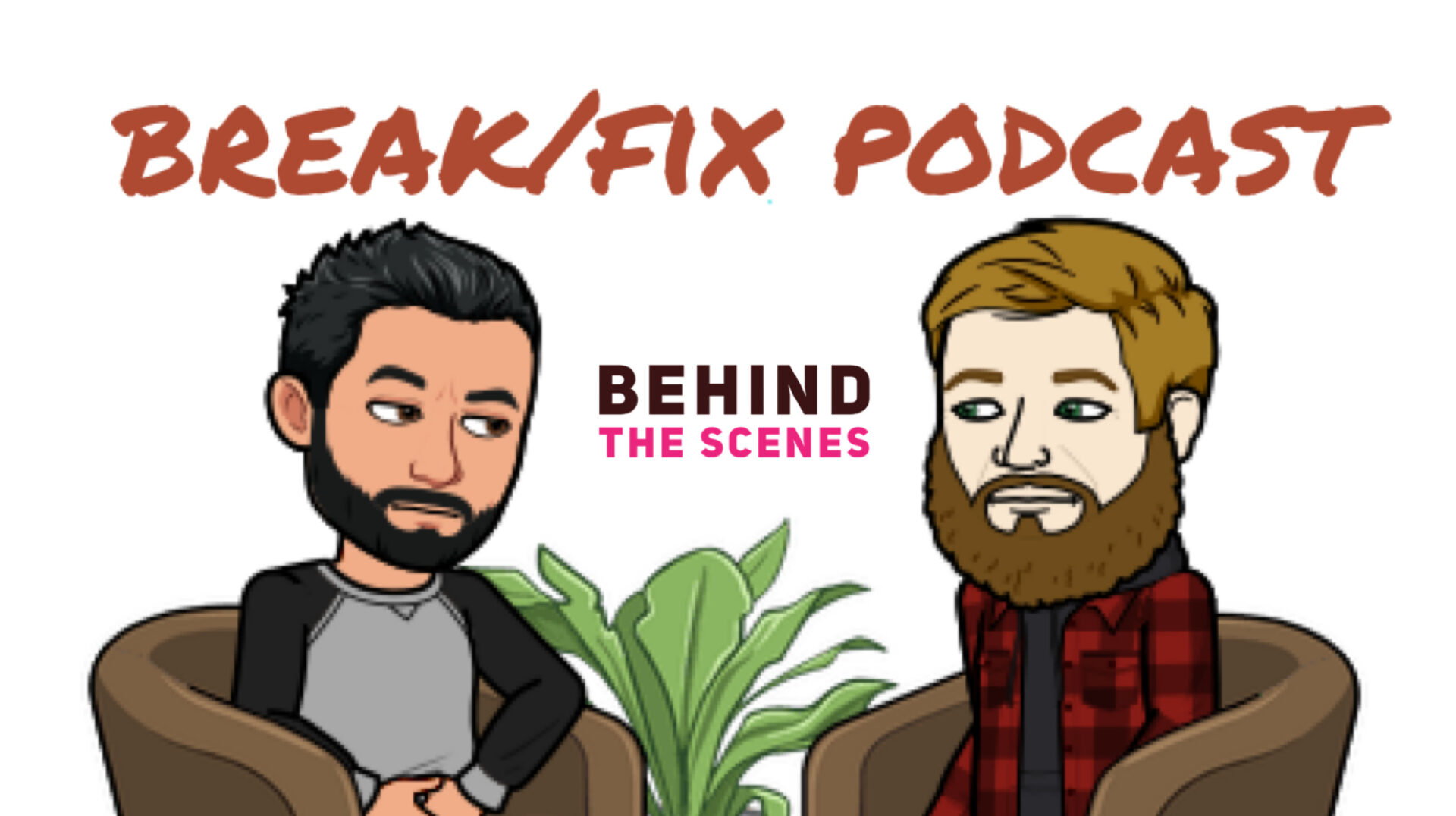
Consider becoming a GTM Patreon Supporter and get behind the scenes content and schwag!
Do you like what you've seen, heard and read? - Don't forget, GTM is fueled by volunteers and remains a no-annual-fee organization, but we still need help to pay to keep the lights on... For as little as $2.50/month you can help us keep the momentum going so we can continue to record, write, edit and broadcast your favorite content. Support GTM today! or make a One Time Donation.

If you enjoyed this episode, please go to Apple Podcasts and leave us a review. That would help us beat the algorithms and help spread the enthusiasm to others by way of Break/Fix and GTM. Subscribe to Break/Fix using your favorite Podcast App:
 |  |  |
To quote artist Rick Delanty – “Lyn Hiner’s paintings express the joie de vivre that she so vibrantly embodies in her personality. Whether an abstract study of shape and color, or an emotional impression of land, sky, or sea, Lyn sees through to the essence of what she observes – and more importantly, feels. She describes the world she sees with color, joy, and sensitivity. Her artworks are real life, interpreted through a worshipful lens.”
There's more to this story!
Be sure to check out the behind the scenes for this episode, filled with extras, bloopers, and other great moments not found in the final version. Become a Break/Fix VIP today by joining our Patreon.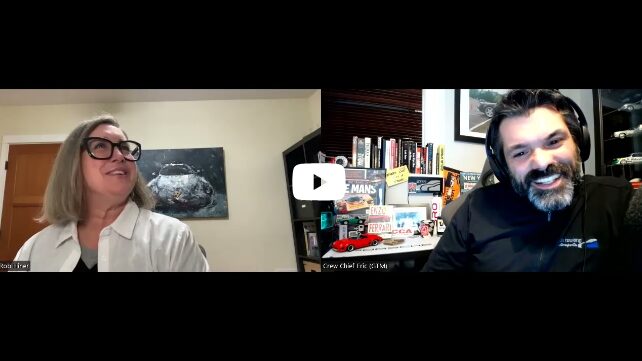
All of our BEHIND THE SCENES (BTS) Break/Fix episodes are raw and unedited, and expressly shared with the permission and consent of our guests.


